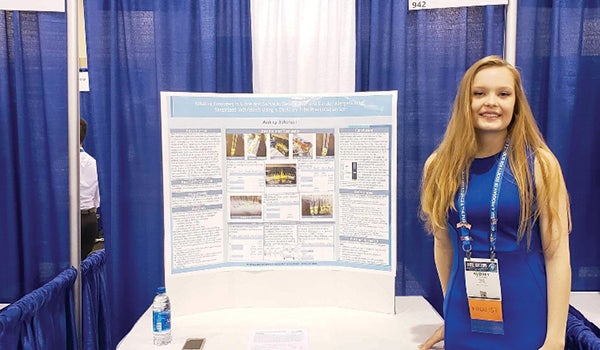Audrey Bakerson seeks to cure allergies through innovative research
Published 10:53 am Monday, July 1, 2019
NILES — A high school research project has led Audrey Bakerson on a quest to cure allergies.
The journey, three years in the making, began during the Niles resident’s first year at the Berrien County Mathematics and Science Center. The program, based at Andrews University, allows highs school students split their time between regular schooling and its accelerated science, technology, engineering and math courses.
All students were required to choose a research project to complete. Bakerson said she loved everything about STEM and decided to research allergy cures. When beginning her research, though, she was led down another avenue first.
“I wanted to go into the prognosis of things, and then I realized there was a gap in non-intrusive allergy testing,” Bakerson said. “So then one thing lead to another, and I started getting results.”
Those results were ways to test someone for allergies without injecting them with an allergen, a standard practice in allergy testing.
“People can go into anaphylactic shock, especially for the young, elderly and people with weakened immune systems,” she said. “It’s not great for them to take those tests.”
Getting a shot is never fun either, she said.
So, instead of pricking people with allergens, Bakerson decided to take urine and saliva samples and comb them with a liquid allergen solution.
The bodily fluid samples contain antibodies, which are blood proteins that combine with and counteracts antigens, which are foreign materials to the body like allergens.
Bakerson chose cat and dog dander as her test antigen of choice because she is allergic to both.
She said she did not expect to find success in her research, which is why the reaction between human sample and allergen took her aback.
“I had these bright neon reactions which is surprising because it’s two clear liquids coming together,” she said.
The color change signified that the person’s antibody was reacting to the antigen, a sign that the person was allergic to the dander.
Bakerson has since spent the past few semesters researching ways to end allergies with her non-intrusive tests. While she is still unsure what her method of curing a person will be, she has an idea. She might use her human samples’ exosomes, or vesicles that mediate immune system responses to pathogens and tumors.
Bakerson laid out the process. First, she will collect a urine or saliva sample. Then, she will isolate the exosomes from the sample and coat them with the sample’s antibodies. This, hypothetically, would make the exosomes non-reactionary toward the allergen.
She would then inject the coated exosomes into her original patient, hopefully curing them of their allergies.
“If I can inject the serum of the antibody back into them, like a shot, then that could be what cures,” Bakerson said. “I’m just trying to figure out what this serum could be.”
To do this, Bakerson said she wants consistency in her testing. That comes at an over $10,000 price tag, she said.
Bakerson has been making liquifying her own antigen solutions in a lab at Andrews University, but that runs the risk of contamination, she said. She hopes to buy regulated antigen solutions, which should increase consistencies in testing while making her work replicable for other scientists, she said.
Grants and personal outreach have attempted solutions to front the cost, but the high school student said she also created a GoFundMe page for prospective small-time donors to help out.
Bakerson, who completed an associate’s degree at Southwestern Michigan College, hopes to finish up her homeschooling education before heading off to a four-year college. She is not sure which institution to attend, but she said she will choose one that has a mentor that is familiar with allergen and exosome research.
Testing exosomes as ways diagnose and cure human issues is a rising field in STEM research, meaning little work studying allergens and exosomes has been done, she said. She is one of the first.
She said despite the stigma of allergies as minor inconveniences to daily life, the work she is doing with exosomes could end up being meaningful to many.
“If you talk about allergies, people are like, ‘Well, it’s just allergies. You don’t have to worry about it,’” she said. “But for people who have intense allergies, it’s pretty complicated. So, it’s kind of nice to be raising awareness.”







